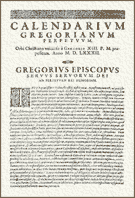


The calendar used throughout the world today is the Gregorian calendar. It is sometimes called a "Christian" calendar, and additional historic information about this calendar, and its precursor, the Julian calendar, are available in the history of the Cristian calendar section.
The Gregorian calendar is the one commonly used today. It was proposed by Aloysius Lilius, a physician from Naples, and adopted by Pope Gregory XIII (portrait above right) in accordance with instructions from the Council of Trent (1545-1563) to correct for errors in the older Julian Calendar. It was decreed by Pope Gregory XIII in a papal bull, Inter Gravissimas, on February 24, 1582 (shown at right). This bull is named "Inter Gravissimas" after its first two words.
In the Gregorian calendar, the tropical year is approximated as 365 97/400 days = 365.2425 days. Thus it takes approximately 3300 years for the tropical year to shift one day with respect to the Gregorian calendar.
The approximation 365 97/400 is achieved by having 97 leap years every 400 years.
The Internatinal Organization for Standardization, ISO, has published a standard on how to write dates, times, and time intervals. This standard is known as ISO 8601. The text below refers to the third edition of that standard, which was published on 1 December 2004. Its title is: ISO 8601:2004, "Data elements and interchange formats - Information interchange - Representation of dates and times."
What years are leap years?
Leap years were introduced to keep New Year’s Day on autumnal equinox. But this turned out to be difficult to handle, because equinox is not completely simple to predict.In fact, the first decree implementing the calendar (5 Oct 1793) contained two contradictory rules, as it stated that:
- the first day of each year would be that of the autmunal equinox
- every 4th year would be a leap year
To remove the confusion, a rule similar to the one used in the Gregorian Calendar (including a 4000 year rule) was proposed by the calendar’s author, Gilbert Romme, but his proposal ran into political problems.
In short, during the time when the French Revolutionary Calendar was in use, the the following years were leap years: 3, 7, and 11.
Is there a 4000-year rule?
It has been suggested (by the astronomer John Herschel (1792-1871) among others) that a better approximation to the length of the tropical year would be 365 969/4000 days = 365.24225 days. This would dictate 969 leap years every 4000 years, rather than the 970 leap years mandated by the Gregorian calendar. This could be achieved by dropping one leap year from the Gregorian calendar every 4000 years, which would make years divisible by 4000 non-leap years.This rule has, however, not been officially adopted.
Do the Greeks do it differently?
When the Orthodox church in Greece finally decided to switch to the Gregorian calendar in the 1920s, they tried to improve on the Gregorian leap year rules, replacing the "divisible by 400" rule by the following:Every year which when divided by 900 leaves a remainder of 200 or 600 is a leap year.This makes 1900, 2100, 2200, 2300, 2500, 2600, 2700, 2800 non-leap years, whereas 2000, 2400, and 2900 are leap years. This will not create a conflict with the rest of the world until the year 2800.
This rule gives 218 leap years every 900 years, which gives us an average year of 365 218/900 days = 365.24222 days, which is certainly more accurate than the official Gregorian number of 365.2425 days.
However, this rule is not official in Greece.
What day is the leap day?
It is 24 February!Weird? Yes! The explanation is related to the Roman calendar.
From a numerical point of view, of course 29 February is the extra day. But from the point of view of celebration of feast days, the following correspondence between days in leap years and non-leap years has traditionally been used:
| Non-leap year | Leap year |
|---|---|
| 22 February | 22 February |
| 23 February | 23 February |
| 24 February (extra day) | |
| 24 February | 25 February |
| 25 February | 26 February |
| 26 February | 27 February |
| 27 February | 28 February |
| 28 February | 29 February |
Many countries are gradually changing the leap day from the 24th to the 29th. This affects countries such as Sweden and Austria that celebrate "name days" (i.e., each day is associated with a name).
What is the Solar Cycle?
In the Julian calendar the relationship between the days of the week and the dates of the year is repeated in cycles of 28 years. In the Gregorian calendar this is still true for periods that do not cross years that are divisible by 100 but not by 400.A period of 28 years is called a Solar Cycle. The Solar Number of a year is found as:
Solar Number = (year + 8) mod 28 + 1In the Julian calendar there is a one-to-one relationship between the Solar Number and the day on which a particular date falls.
(The leap year cycle of the Gregorian calendar is 400 years, which is 146,097 days, which curiously enough is a multiple of 7. So in the Gregorian calendar the equivalent of the "Solar Cycle" would be 400 years, not 7 x 400 = 2800 years as one might be tempted to believe.)
What is the Dominical Letter?
Each ordinary (non-leap) year is assigned a letter in the range A to G which describes what days of the year are Sundays. This letter is called the "Dominical Letter" ("Sunday Letter") of the year.It works in this manner: Assign the letter A to 1 January, B to 2 Jan, C to 3 Jan, ... G to 7 Jan, A to 8 Jan, B to 9 Jan, and so on, using the letters A to G and omitting the leap day.
In a year with Dominical Letter A, all days marked A are Sundays. In a year with Dominical Letter B, all days marked B are Sundays. And so on.
Leap years have two Dominical Letters, one which is used from the start of January until the leap day, and another one which is used for the rest of the year.
The Dominical Letter of 2006 is A. The Dominical Letters of 2008 will be F and E.
When can I reuse my 1992 calendar?
Let us first assume that you are only interested in which dates fall on which days of the week; you are not interested in the dates for Easter and other irregular holidays.Let us further confine ourselves to the years 1901-2099.
With these restrictions, the answer is as follows:
- If year X is a leap year, you can reuse its calendar in year X+28.
- If year X is the first year after a leap year, you can reuse its calendar in years X+6, X+17, and X+28.
- If year X is the second year after a leap year, you can reuse its calendar in years X+11, X+17, and X+28.
- If year X is the third year after a leap year, you can reuse its calendar in years X+11, X+22, and X+28.
But if you also want your calendar’s indication of Easter and other Christian holidays to be correct, the rules are far too complex to be put to a simple formula. Sometimes calendars can be reused after just six years. For example, the calendars for the years 1981 and 1987 are identical, even when it comes to the date for Easter. But sometimes a very long time can pass before a calendar can be reused; if you happen to have a calendar from 1940, you won’t be able to reuse it until the year 5280!
What is the correct way to write dates?
The answer to this question depends on what you mean by "correct." Different countries have different customs.In the U.S.A. a month-day-year format is common:
12/25/1998 or 12-25-1998 |Most other countries use a day-month-year format, such as:
25.12.1998 or 25/12/1998 or 25/12-1998 or 25.XII.1998International standard ISO-8601 mandates a year-month-day format, namely either
1998-12-25 or 19981225.In all of these systems, the first two digits of the year are frequently omitted:
25.12.98 or 12/25/98 or 98-12-25However, although the last form is frequently seen, it is not allowed by the ISO standard.
This confusion leads to misunderstandings. What is 02-03-04? To most people it is 2 Mar 2004; to an American it is 3 Feb 2004; and to a person using the international standard it could be 4 Mar 2002 (although a year specified with only two digits does not conform to the ISO standard).
If you want to be sure that people understand you, you should:
- write the month with letters instead of numbers, and
- write the years as 4-digit numbers.
How does one count years?
In about C.E. 523, the papal chancellor, Bonifatius, asked a monk by the name of Dionysius Exiguus to devise a way to implement the rules from the Nicean council (the so-called "Alexandrine Rules") for general use.Dionysius Exiguus (in English known as Denis the Little) was a monk from Scythia, he was a canon in the Roman curia, and his assignment was to prepare calculations of the dates of Easter. At that time it was customary to count years since the reign of emperor Diocletian; but in his calculations Dionysius chose to number the years since the birth of Christ, rather than honour the persecutor Diocletian.
Dionysius (wrongly) fixed Jesus’ birth with respect to Diocletian’s reign in such a manner that it falls on 25 December 753 AUC (ab urbe condita, i.e., since the founding of Rome), thus making the current era start with C.E. 1 on 1 January 754 AUC.
How Dionysius established the year of Christ’s birth is not known (see History of our Calendar for a couple of theories). Jesus was born under the reign of king Herod the Great, who died in 750 AUC, which means that Jesus could have been born no later than that year. Dionysius’ calculations were disputed at a very early stage.
When people started dating years before 754 AUC using the term "Before Christ," they let the year 1 B.C.E. immediately precede C.E. 1 with no intervening year zero.
Note, however, that astronomers frequently use another way of numbering the years B.C.E. Instead of 1 B.C.E. they use 0, instead of 2 B.C.E. they use -1, instead of 3 B.C.E. they use -2, etc.
The earliest uses of BC dating are found in the works of the Venerable Bede (673-735).
In this section we have used C.E. 1 = 754 AUC. This is the most likely equivalence between the two systems. However, some authorities state that C.E. 1 = 753 AUC or 755 AUC. This confusion is not a modern one, it appears that even the Romans were in some doubt about how to count the years since the founding of Rome.
Continued....



No comments:
Post a Comment